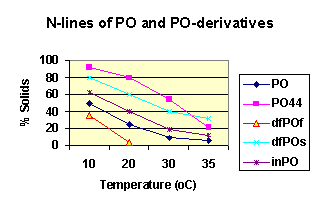| Oil modification
There are 3 ways of Oil modification:
- Hardening or hydrogenation. Under high temperature
condition and by means of a catalyst, unsaturated bounds in the
fatty acid chain are changed into saturated ones by the addition
of hydrogen or the cis-unsaturated form is converted in a trans-unsaturated
form. On this way oils are transformed in fats with various melting
points. Soybean oil (BO) can be transformed in BO35 (melting point
35°C) or BO44 (melting point 44°C)
- Fractionation. By controlled crystallisation
of a fat (e.g. PO), followed by a separation of the crystals from
the partially crystallised mass the fat can be divided in two
parts:
- Hard fraction called stearin: POs or palm stearin
- Soft or fluid fraction called olein: POf or palm olein
- Interesterification or rearrangement. By means
of higher temperature and a catalyst the fatty acids are statistically
rearranged on the glycerol molecule. If two different oils or
fats are used, a completely new triglyceride
composition can be made with other (more desired) properties.
The next picture gives an example of fats made from PO by the various
modification techniques:

PO = straight Palmoil from Malaysia or Indonesia. Palmoil from
Africa and South America can be softer.
PO44 = Palmoil hardened to a melting point of 44°C, widely used
for a number of applications as such or in blends.
dfPOf = palmolein, obtained by dry fractionation (df), used as oil
in warmer countries.
dfPOs = the by-product of the production of dfPOf, used as such
or in interesterified form with e.g. laurics or oil.
inPO = interesterified PO.
 Back to top
Back to top
|